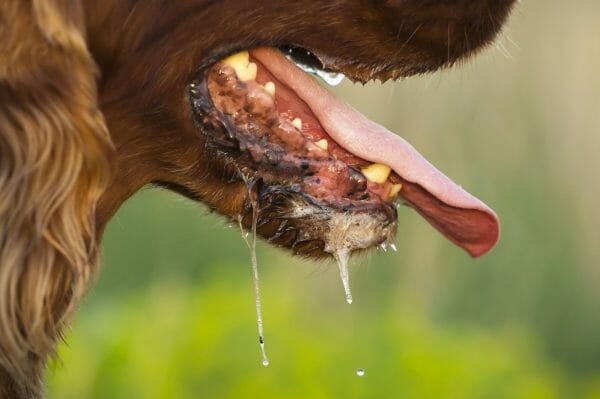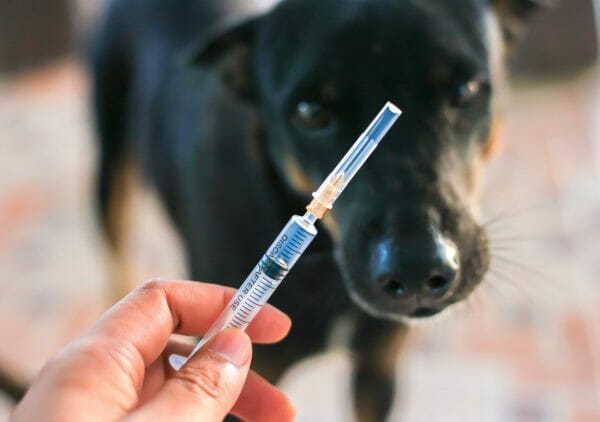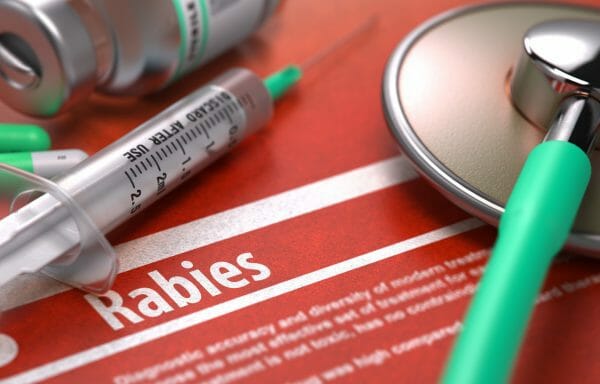Rabies Symptoms in Dogs
Rabies is a vicious viral infection that has the potential to affect any mammal, whether it is a human or animal. All it takes for this virus to spread to an unsuspecting animal is a bite or deep scratch from a rabid animal.
Even if immediate action is taken to counteract the virus, rabies in dogs is almost always a lethal injury in dogs. Once the injury has taken place, the rabies virus may rapidly permeate throughout the body through specific stages. Unfortunately, in other cases, the virus will trigger sudden death without the presence of any stages or symptoms.
Signs of Rabies

It is important to realize that while some dogs exhibit extreme symptoms, others may die without any sign of a problem. Listed below are the common signs associated with this viral disease:
- Pica (consuming inedible substances)
- High fever
- Clear agitation or restlessness
- Seizures
- Unbalanced walking
- Paralysis
- Foaming from the mouth
- Hypersalivation
- Hypersensitivity to sounds or lights
- Facial distortion
If symptoms do arise, the canine has reached the point where death is imminent and the damage from the rabies virus is irreversible. Because of this, it is absolutely imperative that a canine is seen immediately after a wound is sustained from a wild or rabid animal. Dog owners should never wait for symptoms to show up to see a vet.
Stages of the Virus
Listed below are the possible stages the rabies virus may go through before death occurs.
- Prodromal (Incubation): This is a tricky stage to pinpoint. The rate at which the rabies virus develops and spreads throughout an animal’s body may vary from a few days to a few months. The rate of spread will depend on where the dog was bitten, how much of the rabies virus was deposited through the bite, and how critical the bite was.
- Furious: After the first stage is complete, symptoms may begin to manifest in this stage or the paralytic stage. The furious stage is marked by erratic and uncharacteristic behavior. The dog’s disposition may swing to the opposite of what is normal for it. For example, a docile dog may suddenly become hostile and mean, or vice versa.
- Paralytic: If the infection does not manifest in the furious stage, it will most likely do so in the paralytic stage. This phase of the virus includes severe loss of balance, trouble walking or swallowing, and muscle weakness. If these symptoms are seen in tandem, it is likely that the dog may suddenly fall into a coma before succumbing to the virus.

What is Rabies?
Rabies is a type of virus that has a rapid onset and possesses an almost nonexistent survival rate. This disease attacks the spinal cord and parts of the brain, often destroying the central nervous system. The infection is widespread throughout the world, with only a small number of countries being entirely rabies-free. Just as with heartworm, rabies is a problem in every state in the U.S.
How Do Dogs Get Rabies?
Canines can get this infection through a skin-penetrating wound inflicted by a wild or rabid animal. The wound is usually infected through the saliva or blood from the rabid animal.
How Is Rabies Transmitted?
This ravaging virus is usually transmitted via the bite of a rabid dog or a wild animal. Skunks, foxes, raccoons, bats, and coyotes are all species that are known to be frequent carriers of the virus. Injuries sustained after an attack from one of these animals on a canine should be evaluated immediately by a vet.

Can Humans Get Rabies from a Bite?
Because of the fact that this viral infection is zoonotic (which means it can spread from an animal to a human), people can get rabies from a bite of a rabid animal. Although rabies is not as dire of a situation in humans as it is for canines, a bite from a rabid animal should still be taken very seriously. A multitude of severe side effects can occur, similarly to how it does in canines. After thoroughly washing the bite out, it is important to get medical assistance immediately at the hospital.
Is Rabies Treatment Available?
Because of the rapid onset of the rabies virus, its strong potency, and the fact it often manifests asymptomatically, treatment endeavors are rarely successful. Even if symptoms do occur, the virus is already too advanced for any type of treatment to work effectively. There is no single treatment for this virus in existence at this point in time.
Vaccines for Rabies
Due to the extremely high fatality rate associated with this virus, the only surefire way to protect an animal against it is through a rabies vaccine. Fortunately, this is one virus that can be prevented with a vaccine, unlike canine coronavirus.

How Often Do Dogs Need Rabies Shots?
In the United States, it is required by law that dogs receive their first vaccine for rabies between 12 and 16 weeks old. After this initial shot, the dog must then conform to the vaccine schedule established by the specific state the dog lives in. Most states require that a canine be revaccinated for rabies every 1 to 3 years.
Every state has different laws regarding rabies vaccination in dogs, so it is important for owners to be aware of their specific state’s guidelines for the rabies vaccines. Additionally, most states require that dog rabies tags be worn at all times to indicate that the dog is properly vaccinated.
Obeying the laws of each state regarding revaccination schedules and preventative measures is truly the only way to save the lives of countless dogs that may unknowingly be exposed to the rabies virus during their lives.
How to Reduce the Risk of Contracting Rabies
The most effective means of reducing the risk of contracting the rabies virus for animals and humans alike is keeping family pets up-to-date on their rabies vaccines. Animals that are vaccinated regularly at the appropriate times stand the best chance of never having to worry about this type of diagnosis.
However, there are some beneficial steps that individuals can take to guard against this ravaging infection more thoroughly.
- Ensure no food is left outside to attract wild animals to the house.
- Do not allow family pets to roam off into the wilderness unattended.
- Never allow a family member (animal or human) to play with or interact with a wild animal.
- If a pet is bitten or scratched by a wild animal, notify the pet’s vet as soon as possible.
Combining frequent vaccinations with these steps will help to guarantee this viral infection will never be a concern for a family’s beloved canines.



